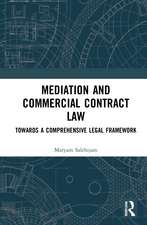Commercial Expectations and Cooperation in Symbiotic Contracts: A Legal and Empirical Analysis
Autor Charles Haward Soperen Limba Engleză Hardback – 14 ian 2020
The possibility of aligning these expectations with the law is considered from the perspective that there is a general duty for parties to cooperate and ensure constructive engagement. The book examines how this might translate into constructive communication, professional governance, genuine attempts to settle issues, a right to fix defects and a duty to take decisions in a fair and rational manner. It argues that statutory adjudication should be extended to all commercial contracts and more ambitious use of available remedies, including those for prevention and cost penalties, would help provide incentives for parties to cooperate more fully.
The book will be of interest to academics in the fields of contract law and of contract management, as well as legal and commercial practitioners.
| Toate formatele și edițiile | Preț | Express |
|---|---|---|
| Paperback (1) | 388.90 lei 43-57 zile | |
| Taylor & Francis – 13 dec 2021 | 388.90 lei 43-57 zile | |
| Hardback (1) | 1000.27 lei 43-57 zile | |
| Taylor & Francis – 14 ian 2020 | 1000.27 lei 43-57 zile |
Preț: 1000.27 lei
Preț vechi: 1219.84 lei
-18% Nou
Puncte Express: 1500
Preț estimativ în valută:
191.40€ • 200.34$ • 159.31£
191.40€ • 200.34$ • 159.31£
Carte tipărită la comandă
Livrare economică 31 martie-14 aprilie
Preluare comenzi: 021 569.72.76
Specificații
ISBN-13: 9780367272111
ISBN-10: 0367272113
Pagini: 310
Ilustrații: 39
Dimensiuni: 156 x 234 x 23 mm
Greutate: 0.45 kg
Ediția:1
Editura: Taylor & Francis
Colecția Routledge
Locul publicării:Oxford, United Kingdom
ISBN-10: 0367272113
Pagini: 310
Ilustrații: 39
Dimensiuni: 156 x 234 x 23 mm
Greutate: 0.45 kg
Ediția:1
Editura: Taylor & Francis
Colecția Routledge
Locul publicării:Oxford, United Kingdom
Public țintă
PostgraduateCuprins
Acknowledgement
Table of Cases
Table of Figures
Table of Tables
Chapter 1 Introduction
1.1 Justifying Contract Law
1.2 What is a Symbiotic Contract?
1.3 Chapter Structure
1.3.1 Chapter 2 -Duty to Cooperate – Case Law and Comment
1.3.2 Chapter 3 Empirical Research Results
1.3.3 Chapter 4 The Source and Justification of the Duty to Cooperate
1.3.4 Chapter 5 The Duty to Cooperate
1.3.5 Chapter 6 Remedies, Antidotes, and Enforcement Mechanisms
1.3.6 Chapter 7 A Few Hard Cases
1.4 Summary
Chapter 2 Duty to Cooperate – Case Law and Comment
2.1 Basic Principle and Overview of Case-Law
2.2 Prevention of performance
2.3 Reasonable Endeavours, Diligence/Facilitation
2.4 Defects and Rights to Cure
2.5 Communication or constructive engagement
2.6 Active Cooperation/Accepting Reasonable Solutions
2.7 Control of Contractual Decision Making
2.7.1 General Principles
2.7.2 Decisions to Exercise Absolute Contractual Rights
2.7.3 Commercial Contracts
2.7.4 Construction Contracts
2.7.5 Taking the Interests of the other Party into account
2.7.6 How to Make a Decision
2.7.7 Conclusion
2.7.8 Appendix A to Chapter 2.7 – typical contract decision making powers
2.8 The Apparatus of Contract Interpretation
2.9 Conclusion
Chapter 3 Empirical Research- Survey and Results
3.1 Methods and Results
3.1.1 Respondent Sample and Demographics
3.1.2 Survey and Interview Design
3.1.3 Survey - General Results
3.2 Open questions – Enjoyment and Success
3.3 The Vignettes/Case Studies
3.3.1 Vignette 1 – The Power and the Story
3.3.2 Vignette 2 – Decide or Concur?
3.3.3 Vignette 3 – An Offer he can’t Refuse?
3.3.4 Vignette 4 – Is It About the Ketchup?
3.4 Themes from the Vignettes
3.4.1 Governance Questions
3.4.2 Negotiation Questions
3.4.3 Punitive Measures
3.4.4 Termination
3.4.5 Fast Track Dispute Resolution Measures
3.4.6 Self-help Remedies
3.5 Cooperation Themes
3.5.1 How Important is Cooperation in the Management of Contracts?
3.5.2 What does Cooperation Mean?
3.5.3 Which Contract Terms Promote Cooperation?
3.5.4 How is Cooperation Achieved?
3.6 Conclusions from this Empirical Evidence
3.6.1 Cooperation is Important
3.6.2 What Cooperation Means
Chapter 4 The Source, Justification and Application of the Duty to Cooperate
4.1 Theoretical Perspectives on Commercial Expectations
4.1.1 The Change in Commercial Reality and Commercial Practice
4.1.2 Meaning of Commercial Expectations
4.1.3 Why These Expectations should be given Legal Force
4.2 The Source of the Duty - Commercial Expectations – Polyfilla, Penumbra or Polysemia? Giving it Some Ayr
4.2.1 Evidence of Market Practice
4.2.2 Custom
4.2.3 The Parties’ History - Overview
4.2.4 The Parties’ History – Prior Dealings
4.2.5 The Parties’ History – Negotiations
4.2.6 The Parties’ History –Subsequent Conduct
4.2.7 Surveys
4.2.8 The Commercial Judge
4.3 Conclusion
Chapter 5 The third way – how it is different
5.1 The Third Way
5.2 Definitions of cooperation
5.2.1 Good Faith in Civil Law
5.2.2 Full-Blooded Relational Scholarship
5.2.3 Other Academic Constructs – Mainstream Obligations Scholars and Hybrid or Para-Relationists
5.2.4 Law and economics definitions
5.2.5 Trust Based Definitions
5.2.6 Managerial Thoughts
5.2.7 Tit-for-tat ≠ cooperation
5.3 Conclusion
Chapter 6 Remedies, Antidotes, and Enforcement Mechanisms
6.1 Remedies for Prevention
6.2 Wrotham Park/Negotiating Damages
6.3 Damages for Failure or Refusal to Negotiate
6.4 Statutory Adjudication
6.5 Limiting the Right to Determine
6.6 Cost Penalties
Chapter 7 A Few Hard Cases
7.1 Medirest
7.2 Portsmouth City Council v Ensign Highways
7.3 The Post Office Litigation
7.4 Yam Seng Pte Ltd v International Trade Corporation Ltd (Yam Seng)
7.5 Bristol Groundschool Ltd v Intelligent Data Capture Ltd
7.6 Communication cases – Mona Oil, AE Lindsay, and Peter Dumenil
7.7 J& H Ritchie Ltd v Lloyd Ltd
7.8 D&G Cars Ltd v Essex Police Authority
7.9 Decision Making Powers – Nash and Lymington
7.10 Day to Day Management – the Mundane and the More Mundane
7.11 Walter Lilly & Co Ltd v Giles Patrick Cyril Mackay and DMW Developments Limited
7.12 General Thoughts on the Cases
Chapter 8 Concluding Thoughts and Suggestion for Reform
Bibliography
Index
Table of Cases
Table of Figures
Table of Tables
Chapter 1 Introduction
1.1 Justifying Contract Law
1.2 What is a Symbiotic Contract?
1.3 Chapter Structure
1.3.1 Chapter 2 -Duty to Cooperate – Case Law and Comment
1.3.2 Chapter 3 Empirical Research Results
1.3.3 Chapter 4 The Source and Justification of the Duty to Cooperate
1.3.4 Chapter 5 The Duty to Cooperate
1.3.5 Chapter 6 Remedies, Antidotes, and Enforcement Mechanisms
1.3.6 Chapter 7 A Few Hard Cases
1.4 Summary
Chapter 2 Duty to Cooperate – Case Law and Comment
2.1 Basic Principle and Overview of Case-Law
2.2 Prevention of performance
2.3 Reasonable Endeavours, Diligence/Facilitation
2.4 Defects and Rights to Cure
2.5 Communication or constructive engagement
2.6 Active Cooperation/Accepting Reasonable Solutions
2.7 Control of Contractual Decision Making
2.7.1 General Principles
2.7.2 Decisions to Exercise Absolute Contractual Rights
2.7.3 Commercial Contracts
2.7.4 Construction Contracts
2.7.5 Taking the Interests of the other Party into account
2.7.6 How to Make a Decision
2.7.7 Conclusion
2.7.8 Appendix A to Chapter 2.7 – typical contract decision making powers
2.8 The Apparatus of Contract Interpretation
2.9 Conclusion
Chapter 3 Empirical Research- Survey and Results
3.1 Methods and Results
3.1.1 Respondent Sample and Demographics
3.1.2 Survey and Interview Design
3.1.3 Survey - General Results
3.2 Open questions – Enjoyment and Success
3.3 The Vignettes/Case Studies
3.3.1 Vignette 1 – The Power and the Story
3.3.2 Vignette 2 – Decide or Concur?
3.3.3 Vignette 3 – An Offer he can’t Refuse?
3.3.4 Vignette 4 – Is It About the Ketchup?
3.4 Themes from the Vignettes
3.4.1 Governance Questions
3.4.2 Negotiation Questions
3.4.3 Punitive Measures
3.4.4 Termination
3.4.5 Fast Track Dispute Resolution Measures
3.4.6 Self-help Remedies
3.5 Cooperation Themes
3.5.1 How Important is Cooperation in the Management of Contracts?
3.5.2 What does Cooperation Mean?
3.5.3 Which Contract Terms Promote Cooperation?
3.5.4 How is Cooperation Achieved?
3.6 Conclusions from this Empirical Evidence
3.6.1 Cooperation is Important
3.6.2 What Cooperation Means
Chapter 4 The Source, Justification and Application of the Duty to Cooperate
4.1 Theoretical Perspectives on Commercial Expectations
4.1.1 The Change in Commercial Reality and Commercial Practice
4.1.2 Meaning of Commercial Expectations
4.1.3 Why These Expectations should be given Legal Force
4.2 The Source of the Duty - Commercial Expectations – Polyfilla, Penumbra or Polysemia? Giving it Some Ayr
4.2.1 Evidence of Market Practice
4.2.2 Custom
4.2.3 The Parties’ History - Overview
4.2.4 The Parties’ History – Prior Dealings
4.2.5 The Parties’ History – Negotiations
4.2.6 The Parties’ History –Subsequent Conduct
4.2.7 Surveys
4.2.8 The Commercial Judge
4.3 Conclusion
Chapter 5 The third way – how it is different
5.1 The Third Way
5.2 Definitions of cooperation
5.2.1 Good Faith in Civil Law
5.2.2 Full-Blooded Relational Scholarship
5.2.3 Other Academic Constructs – Mainstream Obligations Scholars and Hybrid or Para-Relationists
5.2.4 Law and economics definitions
5.2.5 Trust Based Definitions
5.2.6 Managerial Thoughts
5.2.7 Tit-for-tat ≠ cooperation
5.3 Conclusion
Chapter 6 Remedies, Antidotes, and Enforcement Mechanisms
6.1 Remedies for Prevention
6.2 Wrotham Park/Negotiating Damages
6.3 Damages for Failure or Refusal to Negotiate
6.4 Statutory Adjudication
6.5 Limiting the Right to Determine
6.6 Cost Penalties
Chapter 7 A Few Hard Cases
7.1 Medirest
7.2 Portsmouth City Council v Ensign Highways
7.3 The Post Office Litigation
7.4 Yam Seng Pte Ltd v International Trade Corporation Ltd (Yam Seng)
7.5 Bristol Groundschool Ltd v Intelligent Data Capture Ltd
7.6 Communication cases – Mona Oil, AE Lindsay, and Peter Dumenil
7.7 J& H Ritchie Ltd v Lloyd Ltd
7.8 D&G Cars Ltd v Essex Police Authority
7.9 Decision Making Powers – Nash and Lymington
7.10 Day to Day Management – the Mundane and the More Mundane
7.11 Walter Lilly & Co Ltd v Giles Patrick Cyril Mackay and DMW Developments Limited
7.12 General Thoughts on the Cases
Chapter 8 Concluding Thoughts and Suggestion for Reform
Bibliography
Index
Notă biografică
Dr C. Haward Soper (Haward) is an Honorary Associate Professor of Law at the University of Leicester.
Descriere
Exploring the role played by cooperation in the law and management of modern, complex contracts, this book contrasts an in-depth review of case law with a large-scale empirical study of the views of commercial actors responsible for the outcomes of these contracts.



















